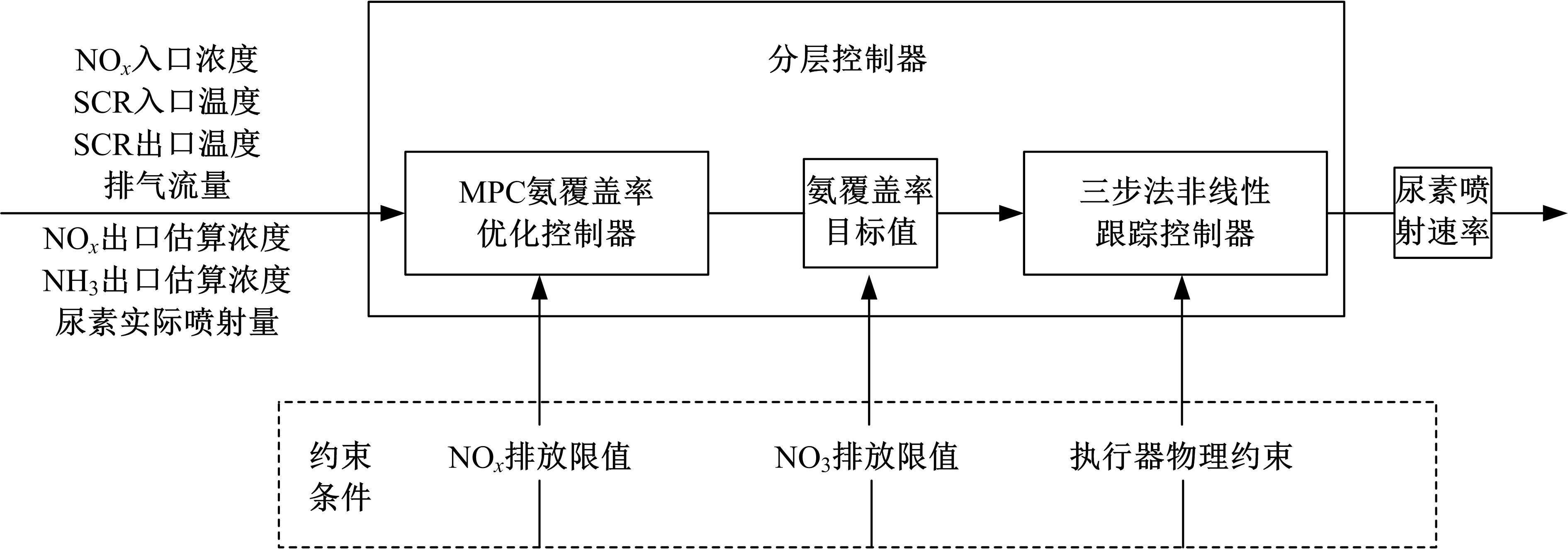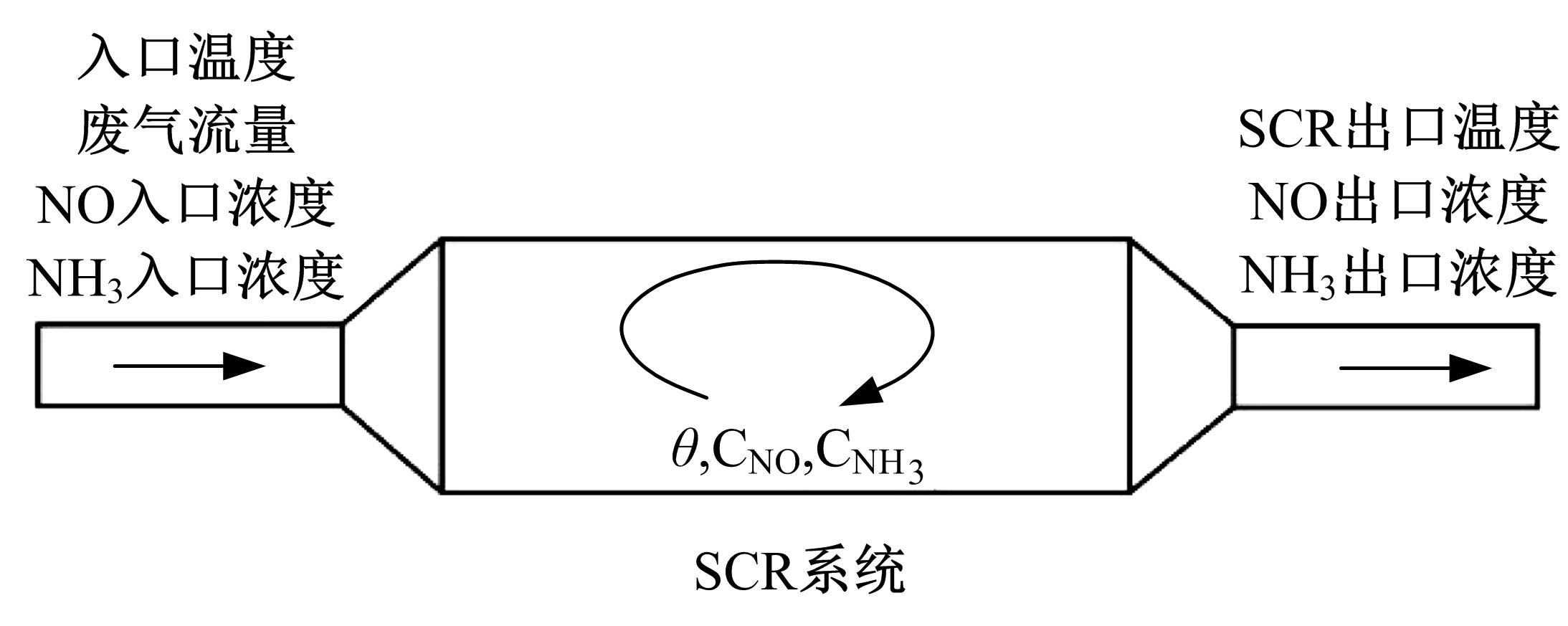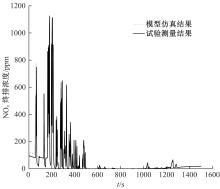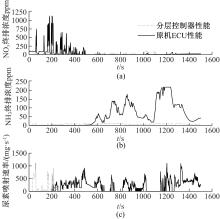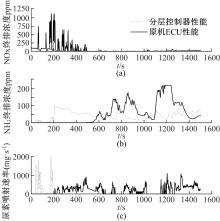吉林大学学报(工学版) ›› 2023, Vol. 53 ›› Issue (1): 61-71.doi: 10.13229/j.cnki.jdxbgxb20210596
基于分层控制器的SCR系统滚动时域优化控制方法
孙耀1( ),胡云峰1,周杰敏2,程欢2,曲婷1(
),胡云峰1,周杰敏2,程欢2,曲婷1( ),赵靖华1,3,陈虹4
),赵靖华1,3,陈虹4
- 1.吉林大学 汽车仿真与控制国家重点实验室,长春 130022
2.东风商用车技术中心,武汉 430056
3.吉林师范大学 计算机学院,吉林 四平 136000
4.同济大学 电子与信息工程学院,上海 200092
Moving horizon optimization control of SCR system based on hierarchical controller
Yao SUN1( ),Yun-feng HU1,Jie-min ZHOU2,Huan CHENG2,Ting QU1(
),Yun-feng HU1,Jie-min ZHOU2,Huan CHENG2,Ting QU1( ),Jing-hua ZHAO1,3,Hong CHEN4
),Jing-hua ZHAO1,3,Hong CHEN4
- 1.State Key Laboratory of Automotive Simulation and Control,Changchun 130022,China
2.Technology Center of Dongfeng Commercial Vehicle,Wuhan 430056,China
3.College of Computer Science and Technology,Jilin Normal University,Siping 136000,China
4.College of Electronic and Information Engineering,Tongji University,Shanghai 200092,China
摘要:
为保证选择性催化还原(SCR)系统的转化效率并减少尿素消耗量,本文基于氨覆盖率设计了一种新颖的分层控制器,上层为模型预测控制(MPC)氨覆盖率优化控制器,实时优化计算得到的氨覆盖率目标值;下层为三步法非线性跟踪控制器,结合类稳态控制、参考前馈控制、变增益反馈控制跟踪参考目标。在仿真环境与原机电子控制单元(ECU)进行对比验证,分层控制器的关键指标均有所提升,氨逃逸下降超过85%,NO x 比排放下降27.4%,尿素消耗量降低5%。结果表明,本文提出的优化方法具有较强的应用价值。
中图分类号:
- U463.6
| 1 | 中华人民共和国生态环境部.柴油货车污染治理攻坚战行动计划[J]. 商用汽车, 2019, 339(1): 6. |
| Ministry of Ecology and Environment of the People's Republic of China. Diesel truck pollution control battle action plan[J]. Commercial Vehicle, 2019, 339(1): 6. | |
| 2 | Zhao J, Chen Z, Hu Y, et al. Urea-SCR process control for diesel engine using feedforward-feedback nonlinear method[C]//The 9th IFAC Symposium on Advanced Control of Chemical Processes, Whistler: Canda, 2015: 367-372. |
| 3 | Reşitoğlu İ A, Altinişik K, Keskin A. The pollutant emissions from diesel-engine vehicles and exhaust aftertreatment systems[J]. Clean Technologies and Environmental Policy, 2015, 17(1): 15-27. |
| 4 | Yuan X, Liu H, Gao Y. Diesel engine SCR control: current development and future challenges[J]. Emission Control Science and Technology, 2015, 1(2): 121-133. |
| 5 | Joshi A. Review of vehicle engine efficiency and emissions[J]. SAE International Journal of Advances and Current Practices in Mobility, 2019, 1: 734-761. |
| 6 | 中华人民共和国生态环境部. 中国移动源环境管理年报(2020)[J]. 中国能源, 2020(8): 1. |
| Ministry of Ecology and Environment of the People's Republic of China. China mobile source environmental management annual report (2020)[J]. China Energy, 2020(8): 1. | |
| 7 | Johnson T, Joshi A. Review of vehicle engine efficiency and emissions[J]. SAE International Journal of Engines, 2018, 11(6): 1307-1330. |
| 8 | Charlton S, Dollmeyer T, Grana T. Meeting the US heavy duty EPA 2010 standards and providing increased value for the customer[J]. SAE International Journal of Commercial Vehicle, 2010, 3(1): 101⁃110. |
| 9 | Walker A. Future challenges and incoming solutions in emission control for heavy duty diesel vehicles[J]. Topics in Catalysis, 2016, 59(8/9): 695⁃707. |
| 10 | Yao M, Wang J. Model-based control of automotive selective catalytic reduction systems with road grade preview[C]//Proceedings of the American Control Conference, Milwaukee,USA, 2018: 7-12. |
| 11 | Johnson T. Vehicular emissions in review[J]. SAE International Journal of Engines, 2013, 6(2): 699-715. |
| 12 | Shimizu K, Satsuma A. Hydrogen assisted urea-SCR and NH3-SCR with silver–alumina as highly active and SO2-tolerant de-NO x catalysis[J]. Applied Catalysis B: Environmental, 2007, 77: 202⁃205. |
| 13 | Hollauf B, Breitschädel B, Sacher T, et al. Highest NO x conversion in SCR catalysts through model based control[C]//SAE Paper, 2011-26-0042. |
| 14 | Upadhyay D, Nieuwstadt M V. Model based analysis and control design of a Urea-SCR deNO x aftertreatment system[J]. ASME Journal of Dynamic Systems, Measurement, and Control, 2006, 128: 737-741. |
| 15 | Devarakonda M, Parker G, Johnson J H, et al. Model- based estimation and control system development in a Urea-SCR aftertreatment system[C]∥SAE Paper, 2008-01-1324. |
| 16 | Chi J N, Dacosta H F M. Modeling and control of a urea-SCR aftertreatment system[C]∥SAE Paper, 2005-01-0966. |
| 17 | 胡静, 赵彦光, 陈婷,等. 重型柴油机尿素SCR后处理系统的控制策略研究[J]. 内燃机工程, 2011, 32(2): 1-5. |
| Hu Jing, Zhao Yan-guang, Chen Ting, et al. Study of control strategy for Urea-SCR after-treatment system of heavy duty diesel engine[J]. Chinese Internal Combustion Engine Engineering, 2011, 32(2): 1-5. | |
| 18 | 胡静, 赵彦光, 陈婷,等. 重型柴油机SCR后处理系统尿素喷射电子控制单元开发[J]. 内燃机工程, 2011, 32(1): 8-11. |
| Hu Jing, Zhao Yan-guang, Chen Ting, et al. Development of urea dosing control unit for SCR after-treatment system of heavy duty diesel engine[J]. Chinese Internal Combustion Engine Engineering, 2011, 32(1): 8-11. | |
| 19 | Hsieh M F, Wang J. Design and experimental validation of an extended kalman filter-based NO x concentration estimator in selective catalytic reduction system applications[J]. Control Engineering Practice, 2011, 19(4): 346-353. |
| 20 | Aliramezani M, Koch C R, Hayes R E. Estimating tailpipe NO x concentration using a dynamic NO x / ammonia cross sensitivity model coupled to a three state control oriented SCR model[J]. IFAC-Papers Online, 2016, 49(11): 8-13. |
| 21 | Stadlbauer S, Waschl H, del Re L. SCR ammonia dosing control by a nonlinear model predictive controller[J]. IFAC Proceedings Volumes, 2014, 47(3): 3018-3023. |
| 22 | 汤佳明. 基于氨存储控制策略的 SCR 系统研究与开发[D]. 无锡: 江南大学机械工程学院, 2018. |
| Tang Jia-ming. Research and development of SCR system based on the control strategy of ammonia storage[D]. Wuxi: College of Mechanical Engineering, Jiangnan University, 2018. | |
| 23 | 谢澜涛, 谢磊, 苏宏业.不确定系统的鲁棒与随机模型预测控制算法比较研究[J]. 自动化学报,2017,43(6): 969-992. |
| Xie Lan-tao, Xie Lei, Su Hong-ye. A comparative study on algorithms of robust and stochastic MPC for uncertain systems[J]. Acta Automatica Sinica, 2017, 43(6): 969- 992. | |
| 24 | 席裕庚, 李德伟, 林姝. 模型预测控制-现状与挑战[J]. 自动化学报,2013,39(3): 222-236. |
| Xi Yu-geng, Li De-lin, Lin Zhu. Model predictive control - status and challenges[J]. Acta Automatica Sinica, 2013,39(3): 222-236. | |
| 25 | Qin S J, Badgwell T A. A survey of industrial model predictive control technology[J]. Control Engineering Practice, 2003, 11(7): 733-764. |
| 26 | Chen H, Gong X, Liu Q F, et al. Triple-step method to design non-linear controller for rail pressure of gasoline direct injection engines[J]. IET Control Theory and Applications, 2014, 8(11): 948-959. |
| 27 | Zhao H Y, Gao B Z, Ren B T, et al. Integrated control of in-wheel motor electric vehicles using a triple-step nonlinear method[J]. Journal of the Franklin Institute- Engineering and Applied Mathematics, 2015, 352(2): 519-540. |
| 28 | 赵靖华, 陈志刚, 胡云峰,等. 基于"三步法"的柴油机urea-SCR系统控制设计[J]. 吉林大学学报:工学版, 2015, 45 (6): 182-192. |
| Zhao Jing-hua, Chen Zhi-gang, Hu Yun-feng, et al. Design of diesel engine's urea SCR system controller using triple-step method[J]. Journal of Jilin University (Engineering and Technology Edition), 2015, 45(6): 182-192. | |
| 29 | 侯加林,王一鸣,展志刚,等. 基于改进型非线性最小二乘法的作物模型隐含参数估计[J]. 农业机械学报,2015, 36(5): 75-79. |
| Hou Jia-lin, Wang Yi-ming, Zhan Zhi-gang, et al. Application of nonlinear least squares method to crop growth structure function simulation model[J]. Transactions of the Chinese Society of Agricultural Machinery, 2015, 36(5): 75-79. | |
| 30 | 李晓东. 同步发电机励磁系统建模及参数辨识[D]. 南京: 南京理工大学自动化学院,2010. |
| Li Xiao-dong. The modeling and parameter identification of excitation system of Synchronous generator[D]. Nanjing: College of Automation, Nanjing University of Technology, 2010. |
| [1] | 王德军,张凯然,徐鹏,顾添骠,于文雅. 基于车辆执行驱动能力的复杂路况速度规划及控制[J]. 吉林大学学报(工学版), 2023, 53(3): 643-652. |
| [2] | 谢波,高榕,许富强,田彦涛. 低附着路况条件下人车共享转向系统稳定控制[J]. 吉林大学学报(工学版), 2023, 53(3): 713-725. |
| [3] | 申富媛,李炜,蒋栋年. 四旋翼无人机寿命预测和自主维护方法[J]. 吉林大学学报(工学版), 2023, 53(3): 841-852. |
| [4] | 何德峰,周丹,罗捷. 跟随式车辆队列高效协同弦稳定预测控制[J]. 吉林大学学报(工学版), 2023, 53(3): 726-734. |
| [5] | 高金武,王义琳,刘华洋,王艺达. 基于滑模观测器的质子交换膜燃料电池阴极进气系统解耦控制[J]. 吉林大学学报(工学版), 2022, 52(9): 2156-2167. |
| [6] | 胡云峰,于彤,杨惠策,孙耀. 低温环境下燃料电池启动优化控制方法[J]. 吉林大学学报(工学版), 2022, 52(9): 2034-2043. |
| [7] | 高金武,贾志桓,王向阳,邢浩. 基于PSO-LSTM的质子交换膜燃料电池退化趋势预测[J]. 吉林大学学报(工学版), 2022, 52(9): 2192-2202. |
| [8] | 李昂,杨泓渊,雷小萌,宋凯文,千承辉. 基于等效连杆模型的六足机器人行进姿态闭环控制[J]. 吉林大学学报(工学版), 2022, 52(7): 1696-1708. |
| [9] | 吴文静,战勇斌,杨丽丽,陈润超. 考虑安全间距的合流区可变限速协调控制方法[J]. 吉林大学学报(工学版), 2022, 52(6): 1315-1323. |
| [10] | 李文航,倪涛,赵丁选,张泮虹,师小波. 基于集合卡尔曼滤波的高机动救援车辆主动悬挂控制方法[J]. 吉林大学学报(工学版), 2022, 52(12): 2816-2826. |
| [11] | 朱航,于瀚博,梁佳辉,李宏泽. 基于电场模型的无人机搜寻改进算法及仿真分析[J]. 吉林大学学报(工学版), 2022, 52(12): 3029-3038. |
| [12] | 彭浩楠,唐明环,查奇文,王伟忠,王伟达,项昌乐,刘玉龙. 自动驾驶汽车双车道换道最优轨迹规划方法[J]. 吉林大学学报(工学版), 2022, 52(12): 2852-2863. |
| [13] | 杨志军,高忠义,王丽君,黄观新,危宇泰. 面向刚柔耦合定位平台的模型预测控制算法[J]. 吉林大学学报(工学版), 2022, 52(12): 2806-2815. |
| [14] | 鲜斌,张诗婧,韩晓薇,蔡佳明,王岭. 基于强化学习的无人机吊挂负载系统轨迹规划[J]. 吉林大学学报(工学版), 2021, 51(6): 2259-2267. |
| [15] | 许芳,张君明,胡云峰,曲婷,曲逸,刘奇芳. 智能车辆路径跟踪横纵向耦合实时预测控制器[J]. 吉林大学学报(工学版), 2021, 51(6): 2287-2294. |
|
||

